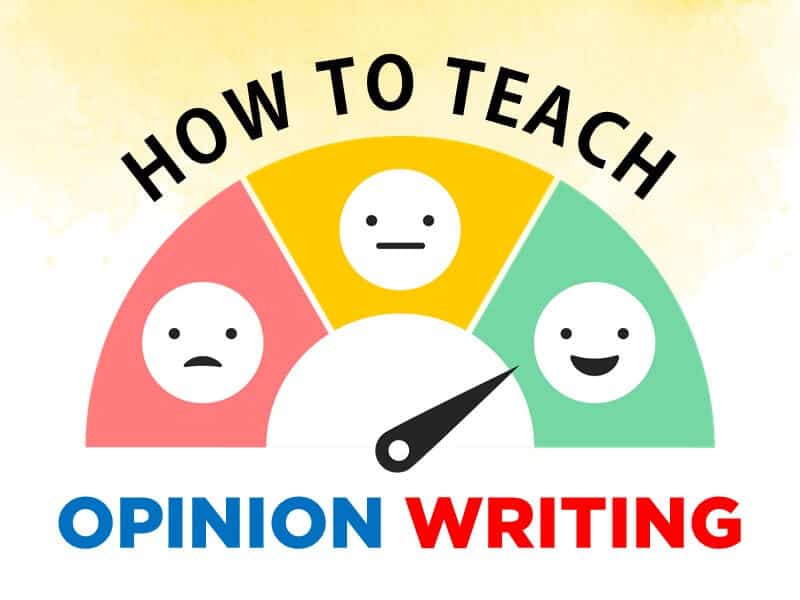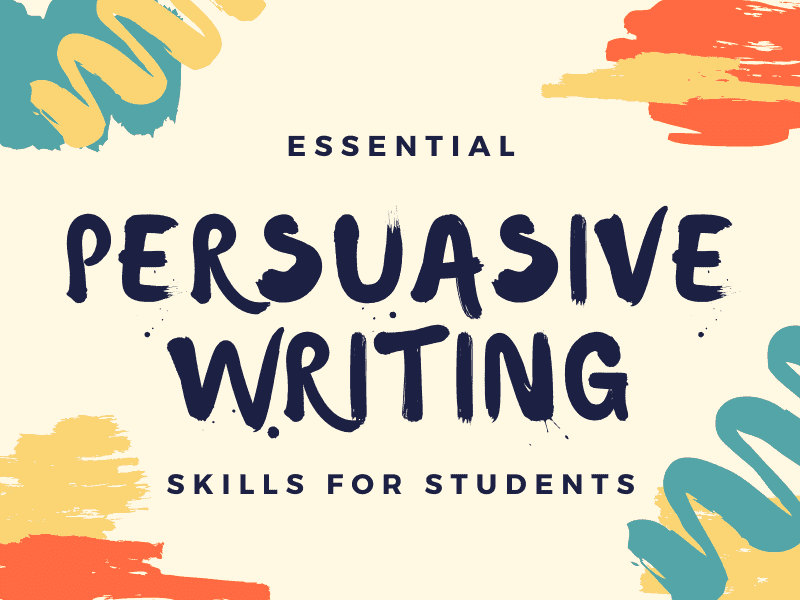
The Importance of Opinion Writing
Encouraging our students to express their personal opinions is an important part of the learning process; healthy even. To do this effectively, it is equally important that we help them acquire the necessary skills to express these opinions in a reasoned and coherent manner when teaching opinion writing.
Writing is one of the best possible vehicles for our students not only to express their opinions but to explore the strength and validity of those opinions.
CONSIDERATIONS BEFORE WRITING AN OPINION ESSAY
For our students to competently express their opinions in writing, they must first understand the specific requirements of the type of question they are answering. Of course, there are many types of questions and fun opinion writing prompts that are geared towards coaxing personal opinions from a student and each will require its own specific tailored response.
It’s clear that personal opinions permeate a wide range of genres and media. We find opinions everywhere from hotel reviews and infomercials to political commentary and newspaper editorials. But, despite the diversity of forms opinion writing can take, we can helpfully identify some general criteria that will assist our students in navigating the challenge of most opinion writing prompts and questions.
Let’s take a look at some of these criteria in more detail.
OPINION WRITING CRITERIA TO ADDRESS
1. Identify the Audience: Speak Clearly
Writing is about language and language is about communication; students should understand that we do not write in a vacuum. The purpose of an essay, letter, or any other form of writing we care to name, is ultimately to be read.
This means that it is essential that consideration be given to the character of the intended audience. Also, remind students that when they are writing, the reader is not privy to the inner workings of the writer’s mind. They must make their thoughts explicit in their writing and ensure that these thoughts are expressed in a coherent manner.
The student writer should always avoid making the assumption that the reader knows things that are not expressed explicitly in the writing.
2. Take a Stance: Stand Firm
From the very outset, the student should state their position boldly. More than that, they must stand firm in that opinion throughout the entirety of the piece.
Opinion writing is not about communicating a series of pros and cons or discussing at length the various related advantages and disadvantages, the place for that is not here. The opinion piece should open with a bold statement of opinion that is clearly expressed, and that opinion should be held unwaveringly and reinforced constantly throughout the text.
As with many other writing genres, employing a hook to grab the reader’s attention is good practice too. This hook can take the form of a quotation, an anecdote, a statistic, or even a joke. Whatever form the hook takes, it should reveal the writer’s take on things too.
To summarize, whatever the topic and however the student opens their opinion piece, they should ensure they express their opinion immediately and coherently. There should be no doubt in the reader’s mind as to where the student-writer stands on the issue.
3. Choose Appropriate Evidence: Back It Up
There is no doubt that subjectivity is an important aspect of opinion writing in general. That does not mean, however, that opinions do not need to be substantiated.
Your students will need to recognize that each and every statement of opinion will need to be supported by appropriate evidence. This will also help students to develop their critical reading skills as they will be able to better recognize when unsubstantiated claims are made by other writers. Opinions backed up with evidence help lead the reader along the writer’s pathways of thought; making the writing more convincing as a whole.
This evidence can take a wide variety of forms, ranging from personal anecdotes and quotations to statistics and references to scientific studies. Students should also always be encouraged to choose evidence that is broadly suited to the subject they are writing about.
4. Draw Conclusions: Wrap It Up
In the well-organized piece of opinion writing, as with many other types of extended writing, the writing should be structured in paragraphs. Paragraphs are essential elements of good writing organization.
Generally speaking, an opening paragraph gives way to body paragraphs. These body paragraphs, or development paragraphs, describe in more detail the ideas laid out in the initial opening paragraph by further exploring, explaining, and providing supporting evidence for each point.
The final concluding paragraph serves to close the circle by restating the central points in a closing endeavor to drive home the writer’s opinion.
5. A Word on Words
Writing is an art form. Attention to detail is important. But, it isn’t only important to look at the big picture things like structure, students should be encouraged to shift their focus from the text level down to the word and sentence levels too. In an opinion piece, strong, forceful verbs should be the order of the day. There is little space for passive forms when engaged in the construction of convincing arguments.
Things should be kept interesting too. Students should vary their sentence structures grammatically and in length. Variety is key.
As always in writing, editing should be emphasized. The editing process polishes the well-wrought opinion piece by putting the final gloss on the student’s work.
The OREO Opinion Writing Process Explained
As with all genres, there’s a lot to remember here and acronyms are a helpful way to commit these important things to memory. Luckily, few things can be easier to commit to memory than the name of a delicious cookie:
O – Opinion
R – Reasons
E – Evidence or Examples
O – Opinion (restated)
This memorable acronym will help students remember some of the main elements of opinion writing as outlined above. But, sometimes the hardest thing for students to do is to get the writing ball rolling.
Opinionated Sentence Starters
Sentence starters provide students with great ways to kick-start their writing. Reminding students of simple ways of introducing opinion sentences can be helpful. Here are a few for ‘starters’ for starters:
● In my opinion…
● I think that…
● It seems to me that…
● It appears to me…
● I feel that…

Once the student-writer has effectively expressed their opinion on a matter, they then will need to provide the reader with the reasons for why they think what they think. In an essay, these reasons will usually be found in the body paragraphs or development paragraphs. Normally, these paragraphs will explore a single reason each.
Some helpful sentence starters for introducing these reasons include:
● One reason I feel this way is…
● Evidence to support this can be found in…
● I believe this to evident in…
Opinion Writing Activities for Students
Students will certainly need practice completing sustained pieces of opinion writing, but some of the most valuable activities to help students evolve their opinion writing abilities barely require a pen to be put to paper.
While the following two activities do not require students to engage in extended pieces of writing, the activities below will assist students in grasping some essential concepts. These activities demonstrate good practice through modelling and also encourage dialogue, discussion, and debate as a means to strengthen opinion writing.
Activity 1: Opinion Writing – What Is It?
This exercise is a good follow-up to introductory work outlining the criteria of opinion writing as described above.
● Start by passing out copies of a piece of opinion writing you have selected to read with the class. Read the text aloud as the students follow along with their copy. The opinion text chosen can come from a wide range of genres, including advertisements, letters, editorials, essays, articles, or reviews.
● Assign students a talking partner and instruct students to take five minutes to identify the various criteria employed in the text. Encourage students to mark and annotate their copies of the text accordingly. You may even wish to supply students with a checklist compiled from the criteria mentioned previously in this article.
● As a whole class, discuss how successfully the text fulfills the criteria. What did the writer do well? What could they have done better? You can record their responses on the whiteboard.
The aim of this exercise is for students to hone their critical faculties while internalizing the criteria. This will reap rewards when the students later engage in their own extended opinion writing.
Activity 2: The Collaborative Case
This activity employs collaboration to help students build a stronger case for their opinion on a divisive issue.
● First, define the parameters of the exercise by presenting an either/or conundrum to the class. This doesn’t have to be overly controversial in nature, just stated in such a way that it forces the students to take one side or another. This could be stated simply as a choice, e.g. Dogs or cats? City or countryside? Beach or Mountains? Sweet or savory?
● Students then divide into two groups according to their stated preferences. In their groups, they then discuss and compile as many supporting reasons for their choice as they can come up with. As a group, they will discuss the relative merits of each reason, before agreeing on their top five.
● The groups then share their reasons in a debate format, using arguments and counter-arguments, leading into an open, free-ranging discussion.
The value of this exercise lies in the collaborative and ‘combative’ natures of the exercises. Just as our physical muscles can grow through resistance, so too can the strength and resilience of our opinions and arguments.
This activity can also be used as a lead-in to opinion writing as it works well as a prewriting preparation exercise. The complexity of the issue to be discussed and debated can easily be modified to suit the abilities of the students too.
OPINION WRITING VIDEO TUTORIALS
These videos from teaching without frills are an excellent starting point for opinion writing. You can view the entire collection here.
The Wrap Up
Opinion writing is a higher-level skill that makes many demands on our students. It will challenge them to move beyond parroting the facts and figures they have acquired in their learning to formulate their own thoughts on topics they have learned about in class, or in the wider world beyond the school gates.
It will make demands on their skill as writers too. Our students must learn to mold and mechanically manipulate the language on the page to express their beliefs persuasively and effectively. To do this successfully, they will need ample opportunities to practice their writing craft. Once a firm understanding of the structures involved has been established, the student can become more fluid in their expression. They will add art and flair to their craft. But first, they must build on these firm foundations.









